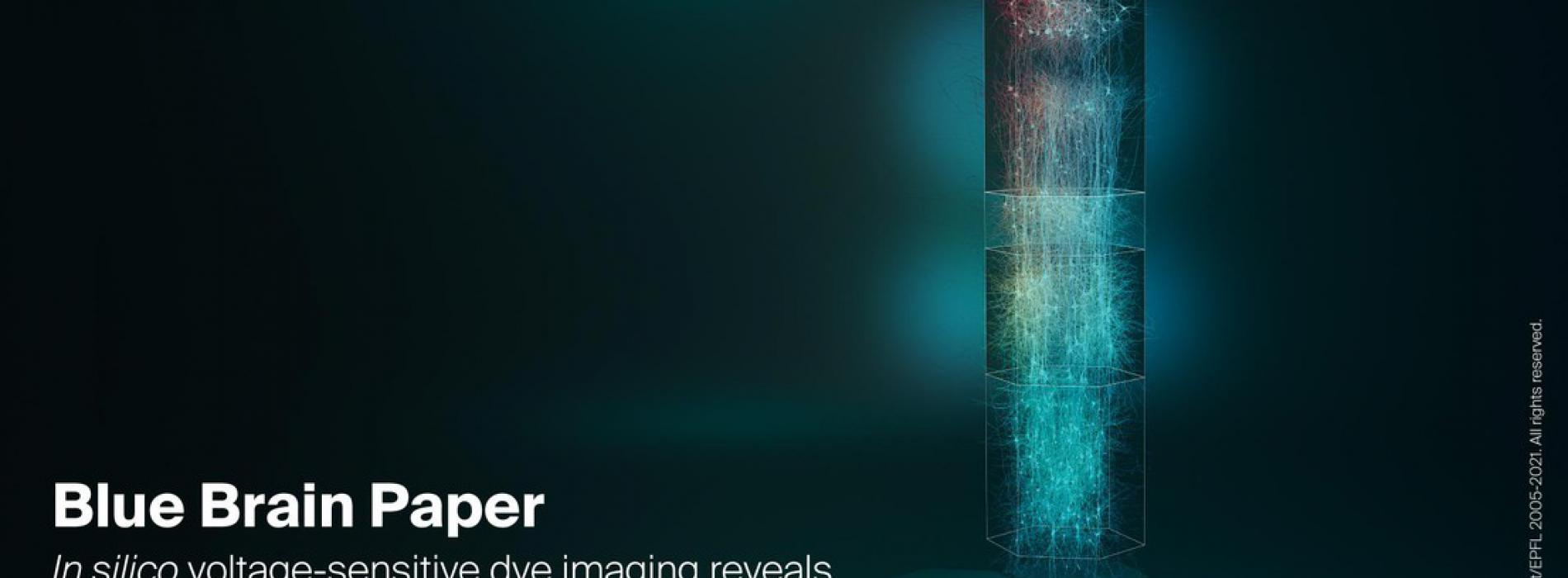
 News
News
Voltage-sensitive dye simulations reveal how neurons work together
Voltage-sensitive dye imaging (VSDI) is a potentially powerful technique to track the electrical activity of thousands of neurons in the brain. However, the light signals generated when light interacts with dyes that are applied to the brain is so complex that it has been difficult to develop the full potential of this technique. In particular, it has been challenging to separate the thousands of light pulses coming from each neuron. To solve this problem, Blue Brain researchers simulated light traveling through a model brain and interacting with dye molecules. They could see, for the first time, how thousands of neurons work in groups.
The paper published in Nature Communications details how this bottom-up in silicoapproach successfully captures large-scale dynamics in rodent cortex revealing a propagating wave front when the brain is stimulated. Thanks to their brain model, the researchers could also work out which neurons were generating the signals. To help understand how researchers can use the VSDI technique, they studied how sensitive this technique is and found that signals more than 25 micrometers apart can be separated.
The EPFL Blue Brain Project is pioneering simulation neuroscience as a complementary approach to understanding the brain, alongside experimental, theoretical and clinical techniques. One of the key advantages afforded by simulations is the ability to study emergent phenomena, i.e. those phenomena that arise as a result of many interactions across spatiotemporal scales. Neuroscientists can measure markers of gene expression, record from groups of individual cells, or image wide swathes of cortex, but understanding how these scales are linked is difficult, especially as one descends towards smaller and faster phenomena. Brain simulation studies permit the study of many micro-variables and their interactions, which ultimately give rise to properties observed at the macroscale.
The published study shows how simulation neuroscience can help to inform the use of some techniques that are being developed to treat brain disorders. For example, researches can now use the genetic machinery in neurons to build and express light sensitive ion channels on their membranes and then use light pulses to activate or suppress the activity of specific neurons to potentially treat a wide variety of brain diseases. Understanding how light passes through the brain and interacts with neurons and these proteins on the neurons has been one of the missing keys to developing these treatments.
A bird's eye view
Lead author, Taylor Newton explains, “Voltage-sensitive dye imaging (VSDI) provides a sort of ‘bird's eye view’ needed to read out mesoscale patterns of activity in a brain simulation, which may be compared to laboratory VSDI experiments. In this study, we show how simulations can be used to understand the cellular processes that underlie certain features of imaging signals, adding depth and nuance to their interpretation. The results of our research demonstrates the strength of simulation-based approaches for understanding brain dynamics across scales, from single cells, to entire networks,” he enthuses.
Going beyond the reach of current experimental techniques
“Simulation neuroscience gives you X-ray-like vision into what is happening in the brain. This remarkable PhD thesis work now also shows that it can be used to help us develop futuristic medical diagnostic and treatment technologies, and new ways to interface and interact with the brain,” says Prof. Henry Markram, Founder and Director of the Blue Brain Project.
For more information, please contact Blue Brain’s Communications Manager – Kate Mullins
Read the paper - Newton, T. H., Reimann, M. W., Abdellah, M., Chevtchenko, G., Muller, E. B., & Markram, H. (2021). In silicovoltage-sensitive dye imaging reveals the emergent dynamics of cortical populations. Nature Communications, 12(1), 3630. https://doi.org/10.1038/s41467-021-23901-7
Funding
This study was supported by funding to the Blue Brain Project, a research center of the École polytechnique fédérale de Lausanne, from the Swiss government’s ETH Board of the Swiss Federal Institutes of Technology.